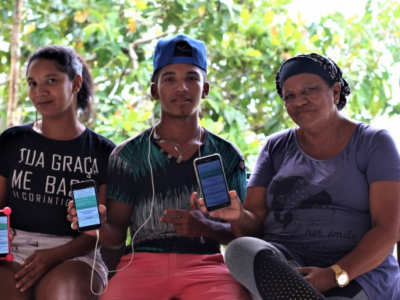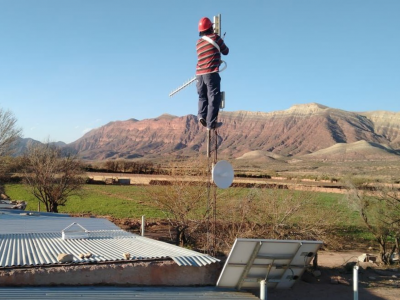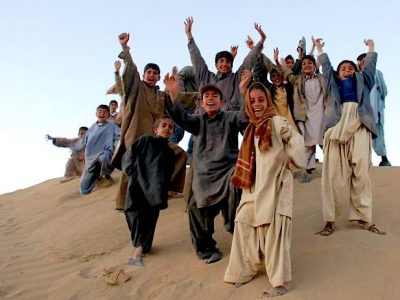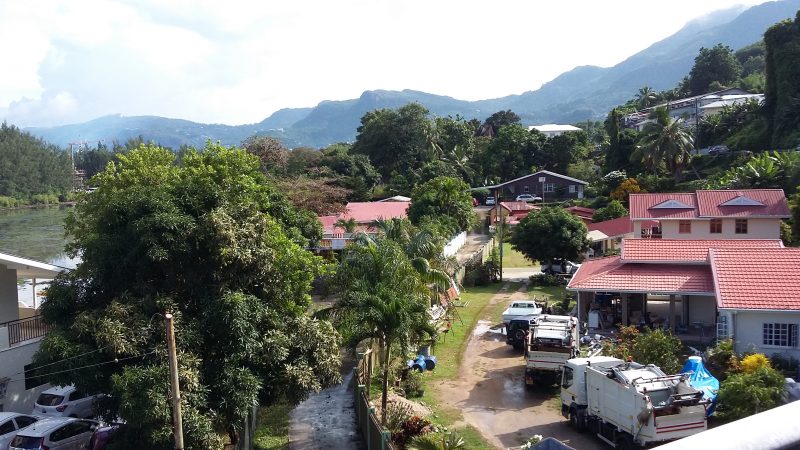
Photo of a typical community in the Seychelles. Photo by Janick Bru and used with permission.
Rising Voices (RV) is partnering with the Association for Progressive Communications (APC) which produced the 2018 Global Information Society Watch (GISWatch) focusing on community networks defined as “communication networks built, owned, operated, and used by citizens in a participatory and open manner.” Over the next several months, RV will be republishing versions of the country reports highlighting diverse community networks from around the world.
This country report was written by Janick Bru, an independent researcher, who liaised with the National Institute for Science, Technology and Innovation (NISTI) and the Seychelles Community Training Institute (SECTI) for information about their projects. Please visit the GISWatch website for the full report which is also available under a CC BY 4.0 license.
There are no community networks in the Seychelles, an archipelago whose population is found essentially on four granitic, mountainous and densely forested islands. The telephone and internet services for fixed points or mobile phones offered by private telecom companies and internet service providers (ISPs) reach virtually all corners of these islands, although the quality and speed of connection can vary according to location. There are currently 33,000 internet subscriptions in the country, nearly all of them broadband, for around 97,000 inhabitants living in about 25,000 households. Statistics show that 58% of the population are regular or intermittent users of the internet. This means that there is still a significant group of people who do not have access to and may not use the internet, although many may own and use mobile phones. It is believed that this segment is composed of i) the elderly, ii) those with limited education and/or social problems, and iii) those who cannot afford to pay for the internet.
The rate of development in the Seychelles is rapid, and reliance on information and communications technologies (ICTs) is also increasing rapidly. Could community networks be helpful for the 40% or so of the population with no ready access to the internet and the wealth of information available there? This report looks at the situation in order to understand why there are no community networks in the country.
Legislative and regulatory context
According to the Seychelles Broadcasting and Telecommunication Act of 2000, no one is allowed to “provide a broadcasting service, or a telecommunication service, except under, and in accordance with, a licence granted under the Licences Act.” The licence specifies:
(a) The radio frequency or frequencies allocated to the licensee.
(b) The description of the antenna and transmitter to be used.
(c) The geographical area in which a mobile transmitter, where applicable, may be used.
(d) The location of the antenna and fixed transmitter.
(e) The obligation, if any, to share the frequency allocated with any other person.
These regulations were somewhat softened by the Policy on the Use of Fixed Broadband Wireless Access (FBWA) Frequency Bands (FBWA Policy) of 2004, which set out requirements for operating in the 2.4 GHz (2400-2483.5 MHz) and 5.7 GHz (5725-5825 MHz) frequency bands. The Department of Information Communications Technology (DICT) says in the introductory paragraph of the FBWA Policy that it was “created to allow other users to operate low powered short range devices, in the two frequency bands on a licence-exempt basis, whilst protecting the high powered FBWA operation of the two Internet Service Providers (ISPs) in these bands.” It adds that the purpose is so that “all ISPs […] can contribute towards the deployment of wireless access nationwide.” It includes the “general public” under its definition of “other users”. These provisions are nonetheless subject to Part 2, which lists several points emphasising that any such service must “be operated according to the operational requirements set by” the DICT.
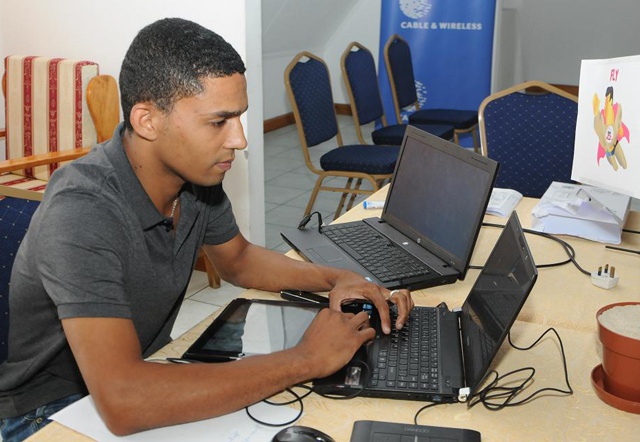
Photo by Patrick Joubert, Seychelles News Agency and used under a CC license.
In practice, a representative of the Seychelles Licensing Authority (SLA) said that anyone who wanted to offer a broadcasting or internet-related service needed to prepare and submit a project to the DICT, which would determine the acceptability of such a project. If the project is approved, then the DICT informs the SLA as to the kind of licence that should be issued. Details of the approval process are not in the public domain.
Collaborative efforts in the Seychelles in the area of ICTs
There are some community access initiatives in the Seychelles that seek to use the potential of ICTs to improve the lives of ordinary citizens. A few of these could, as a next step, consider setting up a community network to further strengthen the community's engagement with, and appropriation of, technology.
There are a number of local community initiatives in the country but they all operate in social areas, where the only formal requirement is to register as an association. To complete registration, the group needs a membership of at least two individuals who agree to work together towards a common goal. Such groups include the Cancer Concern Association (for cancer victims/survivors and their relatives), Night Pastors (for people on the street), and Friends of Prison (to contribute to the rehabilitation of prisoners), to mention a few among the numerous ones that exist.
For example, while researching this report, I was introduced to a recent initiative that aims at providing farmers with access to market information and helping them source buyers. The idea stemmed from a conversation that Manfred Laporte, one of the initiators, had with two friends who are farmers and who were finding it difficult to sell, or find places to sell, their products. Laporte, who owns a UK-based IT company, later met a representative of the Seychelles Agricultural Agency (SAA) and together they approached the Seychelles National Institute for Science, Technology and Innovation (NISTI) for support. They felt that building a knowledge-based economy, as promoted by the Seychelles government, required the existence of platforms for knowledge sharing. The team is currently working on a platform that will link farmers and producers with buyers of agricultural produce while maintaining records of the availability of various items in real time. They are receiving the active support of the DICT which, according to Laporte, has essentially agreed to provide funds for the subscription needed for hosting and operating the platform. This subscription will cost approximately SCR 300,000 (about USD 22,300) annually. As I suggest below, this is a crucial commitment from the government to a grassroots-initiated ICT project, because cost is a key barrier for any ICT initiative to be developed in the Seychelles.
The project is still being developed and Laporte hopes that the first phase will be operational within the third quarter of 2018. Farmers and others should be able to use their mobile phones to access the platform and work offline in order to keep costs low. Laporte states that a number of farmers have agreed to be part of the pilot. “This is now a community effort with members from SAA, NISTI and the farming community,” he says. It remains to be seen what steps will be taken to continue building momentum within this community in order to attract and, more importantly, maintain a high level of participation.
The Seychelles Community Training Institute (SECTI) is an NGO which has developed a social action project to provide basic skills and knowledge to specific groups of citizens so that they become self-dependent “instead of continuing to depend on the state social funds.” One of the specific objectives is to “strengthen or encourage the use of ICT” by developing ICT skills that can be used for various purposes including small projects at the community level. The SECTI’s ICT projects target unskilled young people, those with social problems (including drug addiction) and the older population. Regarding the last group, the organisation feels that ICTs are alien to many individuals aged 40 and above, and that this causes them considerable fear and anxiety. The SECTI’s overall goals may be somewhat broad, but its objectives for e‑literacy and skills development are specific: they wish to offer training to introduce the use of ICTs to members of the community who would otherwise not have the possibility to acquire such knowledge and skills.
Marie-Nella Azemia, the director of SECTI, argues for the importance of disconnected communities getting online:
They need to have access to information and for this you need to use all relevant tools, the internet, mobiles and all apps, to keep abreast. In today’s world, everyone, without exception, needs to know what is going on. You need to network and to have contact with other people, organisations and communities which are in different localities. If you are not connected, if you do not understand what is going on, if you cannot talk and engage with others then you are lost. […] All people need to be empowered so that they take their rightful place in society. This means being able to engage, being able to understand, being able to participate and to contribute – for the development of yourself and of the community.
While there is no experience of community networks in Seychelles, both Azemia and Laporte believe that such networks could be useful for their projects. According to Laporte:
Community networks can bring stakeholders closer in order to achieve common goals, for example as for a health community forum or, in this case, a Seychellois farmers’ community for buying and selling agricultural products, and to contribute to the development of agriculture. It is a convenient way of bringing together all sides to create viable economic progress.
Laporte also highlights the fact that while there may be well-developed infrastructure for ICTs in the country, there is actually very little relevant local information online, and until this is rectified, people in the Seychelles cannot fully benefit from associating at a local level.
Other difficulties highlighted are the slow pace of bureaucratic processes for implementing such ICT projects and the perception that these processes are somewhat opaque. At this point, though, it is felt that the main hurdle for connecting and for accessing information in the Seychelles is the cost.
Key challenges faced in setting up community networks
Overall, the factors that are seen as the main deterrents to the establishment of community networks in Seychelles are:
- High prices for anything ICT related – equipment, services, maintenance
- Regulations regarding equipment and operations that are not always clear and may sometimes seem contradictory.
Despite the wide coverage offered by commercial ISPs, it is evident that areas of need regarding access to the internet still exist, unrelated to geography and location.
The hurdles to overcome, including the cost of services and the cost of equipment as stipulated by existing regulations, might seem too high for a group of average citizens to choose to venture into establishing community networks, and perceived benefits from such networks may not seem worthwhile. The current lack of relevant local content available online is certainly no encouragement – even though developing this content could be a result of setting up a community network.
Benjamin Sonon, who operates a computer services company, believes that it is difficult for individuals to cooperate in ventures such as community networks for various reasons, the main one being the general socioeconomic climate which does not lend itself to cooperative effort, especially when resources, which are scarce for the average person, have to be invested. Daniel Socrate, a Seychellois telecom professional, considers that the absence of community networks in Seychelles represents a lack of perceived need rather than anything else. He feels that while there are technically competent people who could deliver “traditional” cooperative solutions, there is no interest in linking up as communities via such solutions because, in his view, people see neither the value nor the potential of such traditional cooperative efforts.
Another drawback mentioned by some is the fact that the main service providers in the country, fiercely commercial entities, have considerable control over the facilities that exist, as they are joint owners of the fibre optic cables that link the Seychelles to the rest of the world. One individual referred to a major ISP as a “monopoly from colonial times”.
Socrate’s perception, on the other hand, is that “people are linking up as communities via the use of internet through social media platforms such as Facebook and WhatsApp” and that since “more than 60% of the population have access to the internet via their smartphones, the various groups are linking up through the most effective and modern channels.”
Would the existence of community networks benefit communities in the Seychelles? One can argue that they would. They could help to foster greater community spirit and increase collaboration within communities if people were to see the actual benefits – such as lower access costs, the “upskilling” of the community, revenue generation, and an increase in social capital – that could be derived from them. What is necessary is for a pilot project to be set up in the Seychelles to show proof of concept – but for that to happen, it needs government support, and buy-in from the communities themselves.
For more information regarding action steps in the Seychelles, further reading, and ways to get involved, please visit the full report on the GISWatch website.

